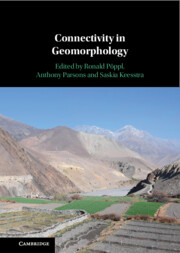Book contents
- Connectivity in Geomorphology
- Connectivity in Geomorphology
- Copyright page
- Contents
- Contributors
- Preface
- Acknowledgements
- Part I Introduction
- Part II Connectivity in Process Domains
- 3 Hillslope Processes
- 4 Fluvial Processes
- 5 Aeolian Processes
- 6 Glacial Processes
- 7 Periglacial Processes
- 8 Coastal and Deltaic Environments
- Part III Quantifying Connectivity in Geomorphology
- Part IV Managing Connectivity
- Index
- References
6 - Glacial Processes
from Part II - Connectivity in Process Domains
Published online by Cambridge University Press: 10 April 2025
- Connectivity in Geomorphology
- Connectivity in Geomorphology
- Copyright page
- Contents
- Contributors
- Preface
- Acknowledgements
- Part I Introduction
- Part II Connectivity in Process Domains
- 3 Hillslope Processes
- 4 Fluvial Processes
- 5 Aeolian Processes
- 6 Glacial Processes
- 7 Periglacial Processes
- 8 Coastal and Deltaic Environments
- Part III Quantifying Connectivity in Geomorphology
- Part IV Managing Connectivity
- Index
- References
Summary
Glacial geomorphic processes can be mapped as a network of vertical and longitudinal connections between process domains in the glacier system, that can stretch from sources in continental interiors to sinks in the oceans, and through which ice, water and debris are transferred or stored. Domains can be defined structurally by their position within a flow system from areas of accumulation through to areas of ablation, but the functional or process-related connection of domains is better defined by geographic and temporal patterns in factors such as temperature that control glacier geomorphic processes. The idea of connectivity has long been important in glacier research, but without much explicit reference to connectivity science or terminology. Debris transport pathways, sediment stores, sediment budgets, and transfers of energy, water and debris through glaciers are fundamental to how glacial geomorphic systems work. There is a clear opportunity for glacial geomorphology to engage more with connectivity theory, as other areas of geomorphology have done, and for connectivity theory to be applied more explicitly to glacial environments.
Keywords
- Type
- Chapter
- Information
- Connectivity in Geomorphology , pp. 102 - 125Publisher: Cambridge University PressPrint publication year: 2025

